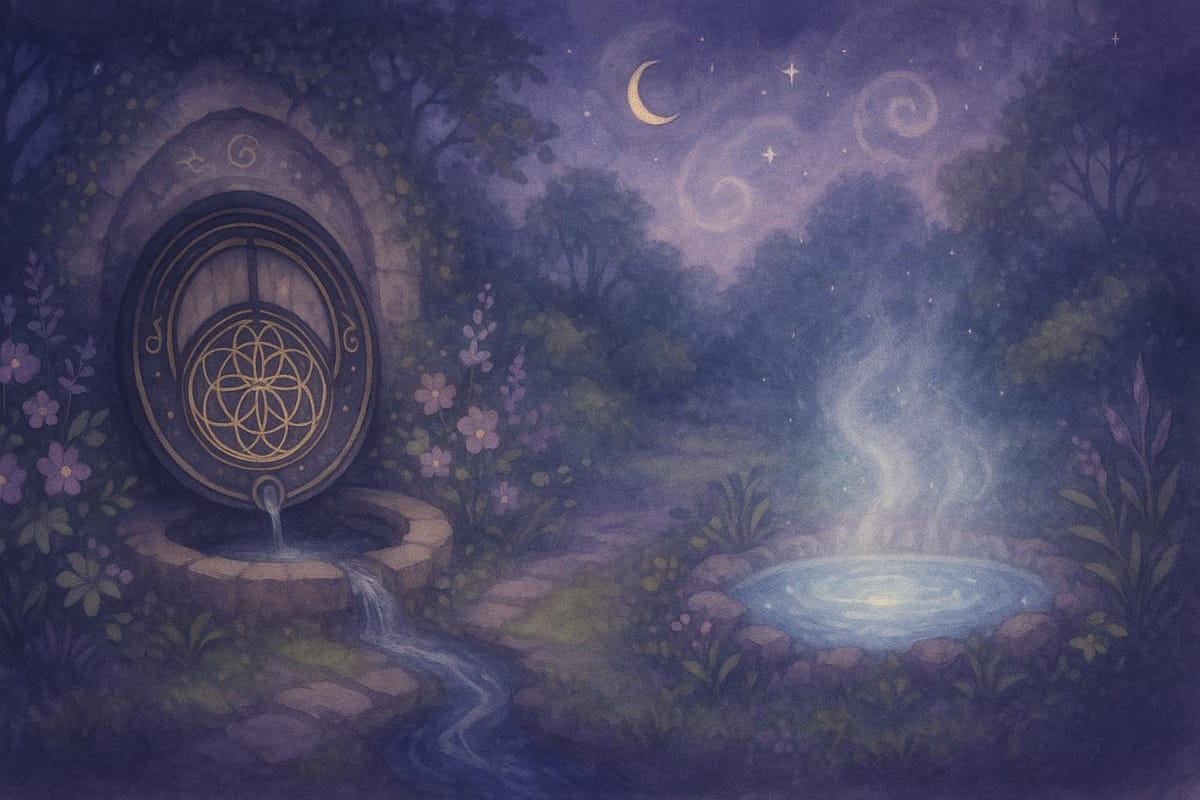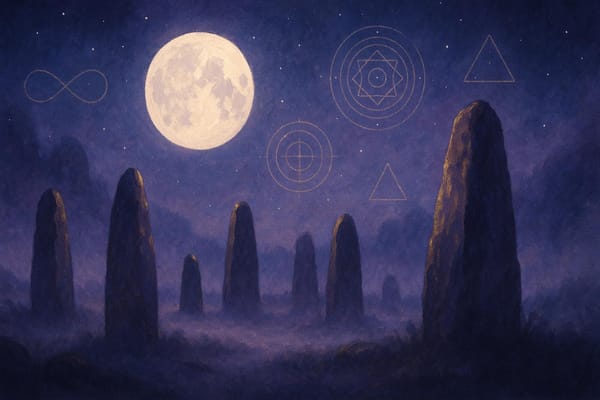Chalice Well & the White Spring: The Alchemical Waters of Avalon
Explore the sacred Chalice Well and White Spring, symbols of balance and transformation in Glastonbury, steeped in rich history and legend.

Did you know? At the base of Glastonbury Tor, two springs - Chalice Well and the White Spring - flow side by side, each offering unique waters and symbolism.
The Chalice Well produces iron-rich red water, while the White Spring flows with calcite-rich white water. Both are revered as sacred sites, symbolizing the balance of masculine and feminine energies.
Key Highlights:
- Chalice Well (Red Spring): Flows consistently year-round at 52°F, symbolizing strength and purification.
- White Spring: Calcite-rich waters housed in a candlelit Victorian well house, representing life and fertility.
- Spiritual Significance: Both springs are linked to legends of Avalon, Celtic mythology, and Christian lore, including ties to the Holy Grail.
- Visitor Experience: Reflect in the Chalice Well's peaceful gardens or immerse in the White Spring's sacred pools.
These springs are not just natural wonders - they are powerful symbols of harmony and transformation, attracting pilgrims and seekers for thousands of years.
Chalice Well: The Red Spring of Ancient Avalon - Megalithomania Tour with Peter Knight
Physical and Spiritual Layout
At the base of Glastonbury Tor, two springs emerge side by side, each carrying its own unique story.
The Chalice Well - often called the Red Spring - sits near the summit of Chalice Hill, while the White Spring is located just down a lane at the Tor’s base. Together, they create a striking physical and symbolic contrast, setting the stage for the interplay of minerals, architecture, and deeper meanings.
Red and White Waters
The distinct colors of these springs come from their mineral compositions. The Chalice Well owes its reddish tint to iron oxide deposits, while the White Spring gets its name from its white calcite deposits.
Interestingly, the White Spring emerges from a shallower source compared to the Chalice Well. This mineral contrast has often been interpreted symbolically - the iron-rich Chalice Well is thought to represent masculine energy, while the calcium-rich White Spring is seen as embodying feminine qualities.
"It is one of the greatest mysteries of the Isle of Avalon that two different healing springs, one touched red with iron, the other white with calcite, should rise within a few feet of each other from the caverns beneath Glastonbury Tor."
Site Architecture and Symbols
Reflecting the duality of the waters, the surrounding structures are rich with symbolic meaning. The Chalice Well is nestled within gardens officially recognized as a World Peace Garden.
Its iconic well cover, designed in 1919 by architect Frederick Bligh Bond, features the vesica piscis symbol - two overlapping circles that symbolize the union of heaven and earth.
In contrast, the White Spring is housed in a Victorian-era well house with three impressive domed vaults, each standing 16 feet high. Inside, the space is softly lit by candles, creating an atmosphere of mysticism. The interior features pools designed with sacred geometric principles, alongside shrines dedicated to Brigid and Our Lady of Avalon.
"The water doesn't come from above. It comes from below and so is not dependent on rainfall and begins its existence deep within the bowels of our Mother, the Earth."
The Chalice Well offers a serene, sunlit garden setting, perfect for quiet reflection. The White Spring, on the other hand, provides a more immersive experience, inviting visitors to engage with its sacred bathing pools. These contrasting environments not only highlight the natural polarity of the springs but also serve as spaces for spiritual exploration and personal transformation.
Origins and Legends
The sacred waters of Glastonbury have been flowing for thousands of years, carrying with them a rich tapestry of history and meaning. Archaeological findings reveal that people have revered these springs across countless generations, with each era adding its own interpretation of their sacred importance.
Let’s delve into how Celtic mythology and Christian legends have shaped the spiritual narrative of these mystical waters.
Celtic and Druid Traditions
In Celtic mythology, wells were seen as portals to the spirit world. Around 2500 BC, the ancient Druids recognized Glastonbury as a spiritual hub, even crafting the enigmatic labyrinth on the Tor. To the Celts, these wells symbolized a direct link to the Earth Mother’s womb.
The springs’ striking red and white hues, deeply rooted in Celtic lore, are tied to the Wild Hunt - a spectral event led by Gwynn ap Nudd, the fairy king and ruler of the underworld. The springs’ unending flow only adds to their otherworldly allure. Over time, these sacred waters took on new meanings as Christianity wove its legends into the landscape.
Holy Grail Connection
Christian lore brought a new dimension to the springs, particularly through the story of Joseph of Arimathea. According to legend, he hid the Holy Grail - the chalice from the Last Supper - near the spring.
This connection led to the Chalice Well being dubbed "The Blood Spring", with the reddish tint of its waters symbolizing the blood of Christ’s Crucifixion.
"What constitutes the magic of Avalon if it is not symbolised by the flooded land of still water, the magic mirror, with the tall finger of the Tor rising above it as the magician's wand of power, and in the middle the little island where the Apples of Wisdom grew?"
The springs also became tied to Avalon, the fabled island of Arthurian legend. Early Celtic Christian hermits, drawn to the sacred energy of the area, settled near the White Spring.
This blending of Christian and pre-Christian traditions created a spiritual legacy that transcends religious boundaries, continuing to attract pilgrims and seekers from all walks of life.
Spring Ceremonies and Practices
Water Rituals
At the Chalice Well, visitors observe moments of silence at 12:00 PM and 3:00 PM, synchronized with the steady flow of 1,000 gallons per hour from the Lion's Head fountain, which remains at a constant 52°F (11°C).
Over at the White Spring, a candlelit temple with sacred pools offers a deeply immersive experience through ritual bathing, available by coordinating with the temple keeper.
The spring’s red, iron-rich water is said to symbolize masculine energy, while the white, limestone-enriched water represents feminine qualities. These two waters are seen as a profound symbol of unity, and pilgrims often honor this connection through personal ceremonies. Together, these rituals align participants with the natural rhythms of the earth.
Sacred Timing
The ceremonies at these sacred sites are closely tied to both cosmic and earthly cycles, with specific dates and practices marking key seasonal and lunar events:
| Seasonal Event | Significance | Traditional Practices |
|---|---|---|
| Summer Solstice | Celebration of peak solar energy | Sunrise walks to the Tor and heart-centered ceremonies |
| Winter Solstice | Marking the return of light | Rituals symbolizing rebirth and light in darkness |
| Beltane (April 30) | Honoring feminine energy | Women's gatherings and ancient magical traditions |
| Full Moon | Amplified spiritual energies | Water blessings and meditative gatherings |
The White Spring also hosts regular ceremonies during both full and dark moons, paying particular attention to seasonal transitions. Private ceremonies, such as baptisms and ritual bathing, can be arranged with the temple keepers for those seeking a more personal experience.
A modern example of these evolving traditions is the Sacred Feminine Rose Womb Mysteries retreat, set to take place in June–July 2024. This event combines traditional water-based rituals with contemporary healing practices, showcasing how ancient wisdom continues to adapt and resonate in today’s spiritual landscape.
For those planning a visit to the springs, it’s important to check the latest schedules, respect designated silent moments, bring containers if you wish to collect water, and follow the guidance of site keepers to ensure proper ceremonial etiquette.
These springs remain a bridge between age-old traditions and modern spirituality, offering a space for healing, connection, and transformation to all who approach with respect and an open heart.
Energy Network of Glastonbury
Heart Energy Center
Glastonbury is often regarded as the heart chakra of the world, anchored by the Chalice Well and White Spring. As William Lee Rand explains:
"Considered to be the heart chakra of the world and an entrance point into higher dimensions, its special features draw healers and other spiritual pilgrims from all over the earth"
This sacred site is also where the Michael and Mary ley lines converge, creating a powerful energetic crossroads. The Chalice Well, with its steady and unwavering flow throughout the year, reflects the enduring spiritual importance of this location.
The unique energy of Glastonbury intertwines love with purpose, blending its heart-centered energy with Shaftesbury's focused intent. This union is said to transform consciousness and promote healing. These energies ripple outward, connecting deeply with the dual dynamics of the springs.
Balance of Opposites
The two springs in Glastonbury - the Red Spring and White Spring - are often seen as an alchemical partnership. Chloe Cousins describes their significance:
"This separation of the Red and White Springs mirrors the separation of the divine feminine/masculine energies within ourselves. Similarly, their reunion represents the reunification of these sacred energies within humanity"
Each spring carries its own distinct energy and symbolism:
| Spring | Energy Type | Symbolic Representation |
|---|---|---|
| Red Spring (Chalice Well) | Divine Masculine | Strength, structure, purification |
| White Spring | Divine Feminine | Life, fertility, Earth Mother |
The Tor, a prominent hill in Glastonbury, is associated with masculine energy, while the surrounding landscape, including the Chalice Well gardens, channels feminine energy. This natural balance supports both personal transformation and collective healing. The College of Psychic Studies highlights the significance of these sacred sites:
"Tracking ley lines, and exploring the energy of the sacred sites upon them, is a powerful and rewarding experience"
This sacred polarity extends far beyond Glastonbury, connecting to over 4,000 spiritually significant sites worldwide. One key feature of this network is the St. Michael's Line, a 350-mile alignment across England that points toward the sunrise on May 8.
Artist Bones tan jones reflects on the experience of engaging with these energy lines:
"Walking those lines of energy [feels] like a way of intentional healing, of showing gratitude and awareness to those places. And, as with the walking, I wanted the singing to be a way of healing too."
Through these interconnected energies, Glastonbury continues to stand as a powerful center for transformation, awakening, and spiritual balance, leaving a lasting mark on Earth's energetic and spiritual evolution.
Conclusion
The Chalice Well and the White Spring stand as enduring symbols of nature's ability to harmonize sacred energies. For over two thousand years, these springs have flowed without pause, carrying deep spiritual meaning. As Wellesley Tudor Pole observed, these springs are rare points on Earth where spiritual energies seem to flow more freely into the physical world.
These springs are more than just ancient traditions; they actively shape the landscape with their transformative energy.
Together, they create a unique space where the divine masculine and feminine energies blend and evolve. This sacred balance is a cornerstone of Glastonbury's spiritual heritage, offering a space for personal growth and connection through the eternal wisdom carried by water.
Today, both springs remain places of profound healing and reflection. The Chalice Well’s gardens provide a nurturing, peaceful environment, while the White Spring’s temple-like atmosphere invites visitors to pause and look inward. These spaces continue to draw modern seekers, offering a chance to connect with timeless energies.
"The primary purpose of the temple is to honour The Spirit of the White Spring and is an expression of gratitude for the gift of pure water. It is a sanctuary, a place of reflection, inspiration and healing, a sacred site of great depth and beauty. It is a living temple."
As they have for countless generations, these waters flow on - offering healing, renewal, and transformation to all who come to seek them.
FAQs
What do the mineral-rich waters of the Chalice Well and the White Spring symbolize, and how do they reflect the balance of masculine and feminine energies?
The waters of the Chalice Well and the White Spring in Glastonbury carry profound symbolic significance, representing the interplay of masculine and feminine energies.
The Chalice Well, with its iron-rich red water, is often seen as a symbol of masculine energy, reflecting qualities like strength, vitality, and action. On the other hand, the White Spring, with its milky calcite water, is linked to feminine energy, symbolizing nurturing, intuition, and receptivity.
These two springs together evoke the idea of opposites coming together, serving as a powerful metaphor for emotional and spiritual balance. For centuries, they’ve been regarded as sacred spaces, offering opportunities for healing, inner alignment, and a connection to the mystical traditions of Avalon. Their contrasting yet complementary energies invite visitors to explore a profound sense of unity and completeness.
What makes the Chalice Well and the White Spring spiritually significant, and how are they connected to the legends of Avalon and the Holy Grail?
The Chalice Well and the White Spring are deeply entwined with the mystical stories of Avalon and the Holy Grail, making them sites of profound spiritual importance.
According to legend, the Chalice Well is linked to Joseph of Arimathea, who is said to have brought the Holy Grail to Glastonbury. The well’s red-tinged waters are often associated with the blood of Christ, symbolizing healing, renewal, and spiritual nourishment. For many, it serves as a sacred place to find inner peace and personal transformation.
The White Spring, known for its milky waters, is often connected to the sacred feminine and the otherworldly Sidhe. Together, the Chalice Well and the White Spring represent a harmonious balance of energies - masculine and feminine, red and white. This duality has made them powerful spaces for those seeking emotional healing, spiritual insight, and rituals that foster inner balance.
What rituals or ceremonies can visitors experience at the Chalice Well and White Spring, and how do they reflect the site's spiritual traditions?
Visitors to the Chalice Well and White Spring can immerse themselves in rituals and ceremonies that reflect the area's rich spiritual history.
At the Chalice Well, seasonal events such as the Summer Solstice and equinoxes bring people together for meditations, community gatherings, and meaningful rituals. For those seeking a quieter moment, weekly meditations offer a peaceful setting for introspection and connection.
The White Spring provides a more intimate and personal experience. Many visitors participate in ceremonial bathing, silent meditation, or private rituals aimed at spiritual cleansing and renewal.
The space, illuminated by candlelight and accompanied by the soothing sound of flowing water, creates a sacred environment perfect for reflecting on the balance of energies and fostering a connection with nature. These practices highlight the site's focus on healing, transformation, and harmony with the divine feminine.




